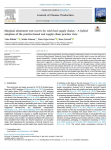Rühlin V., Scherrer M., Crijns-Graus W., Worrell E. (2025). Marginal abatement cost curves for cold food supply chains - A hybrid adoption of the practice-based and supply-chain practice view. Journal of Cleaner Production, 01/08/2025, vol. 518, p. 145902.
https://doi.org/10.1016/j.jclepro.2025.145902
https://doi.org/10.1016/j.jclepro.2025.145902
| Titre : | Marginal abatement cost curves for cold food supply chains - A hybrid adoption of the practice-based and supply-chain practice view (2025) |
| Auteurs : | V. Rühlin ; M. Scherrer ; W. Crijns-Graus ; E. Worrell |
| Type de document : | Article |
| Dans : | Journal of Cleaner Production (vol. 518, August 2025) |
| Article en page(s) : | p. 145902 |
| Langues : | Anglais |
| Langues du résumé : | Anglais |
| Catégories : |
Catégories principales 16 - TRANSPORT. INFRASTRUCTURE. ENERGIE ; 16.1 - TransportThésaurus IAMM CHAINE D'APPROVISIONNEMENT ; FROID ; INDUSTRIE DU FROID ; PRODUIT ALIMENTAIRE ; EFFICACITE ; ENERGIE ; CONSOMMATION D'ENERGIE |
| Résumé : | Cold food supply chains (transportation, processing, shipping, warehousing) consume 19 % of the energy use in the food processing industry. Enhancing energy efficiency can have positive effects on both costs and environmental sustainability. A systemic approach, emphasising optimisations along the entire supply chain, is most effective in this regard, rather than optimising individual entities. This study applies a practice-based and supply-chain practice approach to evaluate the effectiveness of intra- and inter-organisational measures to reduce greenhouse gas (GHG) emissions across different stages and structures of cold supply chains. A hybrid method, combining expert interviews and marginal abatement cost curves (MACCs), was used to identify practices and quantify the GHG emission reduction potential and costs for two selected cold supply chains – fruit & vegetables and dairy products – in the Swiss food industry. The study identified 24 green practices. Findings reveal a 50–70 % GHG emission reduction potential for the fruit and vegetable supply chain and 16–19 % for the dairy supply chain. Practices in refrigerated production and warehousing are generally cost-effective, while practices in refrigerated transport are typically less cost-effective owing to high investment costs in alternative technologies. |
| Cote : | Réservé lecteur CIHEAM |
| URL / DOI : | https://doi.org/10.1016/j.jclepro.2025.145902 |







